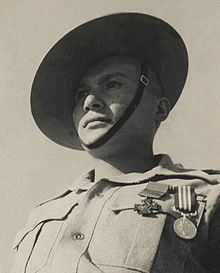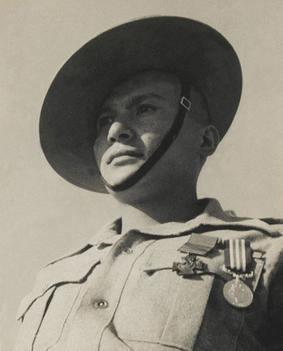Birth name Gyamtso Shangderpa Role Armed force officer Allegiance British India Died July 1, 2000, Sikkim | Years of service 1942 - 1968 Rank Subedar-major Name Ganju Lama Awards Victoria Cross | |
 | ||
Battles/wars World War II
Burma Campaign Battles and wars World War II, Burma Campaign Service/branch British Indian Army, Indian Army Unit 1st Battalion, 7th Duke of Edinburgh's Own Gurkha Rifles | ||
Victoria Cross Recipient |Gurkha Regiment | Ganju Lama V.C | World War Two | For Valour | 1985
Ganju Lama VC MM (22 July 1924 – 1 July 2000) was a Sikkimese Indian recipient of the Victoria Cross, the highest and most prestigious award for gallantry in the face of the enemy that can be awarded to British and Commonwealth forces.
Contents
- Victoria Cross Recipient Gurkha Regiment Ganju Lama VC World War Two For Valour 1985
- Enlistment
- Victoria Cross
- Later life
- References

Enlistment
Ganju Lama was born in Sangmo, southern Sikkim, India, on 22 July 1924. He enlisted in British Gurkha Army in 1942 at the age of seventeen. His parents were both of Sikkimese Bhutia descent and lived in Sikkim, which made him unusual, as he was neither an ethnic Gurkha nor a Nepalese subject. At that time, however, Gurkha regiments were prepared to accept any recruit who closely resembled the Gurkha and lived near the border of Nepal. Ganju Lama's tribe lived in the kingdom of Sikkim. His name was Gyamtso Shangderpa, but a clerk in the recruiting office wrote it down as Ganju, and the name stuck. After leaving the regimental centre in 1943, he joined the 1st Battalion, 7th Gurkha Rifles, near Imphal, India.
Victoria Cross
Ganju Lama was nineteen years old, and a rifleman in the 1st Battalion, 7th Gurkha Rifles, in the Indian Army during World War II when the following deed took place for which he was awarded the Victoria Cross:
On 12 June 1944, near Ningthoukhong, India, 'B' Company was attempting to stem the enemy's advance when it came under heavy machine-gun and tank machine-gun fire. Rifleman Ganju Lama, with complete disregard for his own safety, took his PIAT gun and, crawling forward, succeeded in bringing the gun into action within 30 yards of the enemy tanks, knocking out two of them. Despite a broken wrist and two other serious wounds to his right and left hands he then moved forward and engaged the tank crew who were trying to escape. Not until he had accounted for all of them did he consent to leave to his wounds dressed.
A month earlier, during operations on the Tiddim Road, Ganju Lama's regiment had surprised a party of Japanese and killed several of them. He was awarded the Military Medal for his part in the action. Strangely though, this award was actually announced in the London Gazette after his Victoria Cross, appearing on 3 October 1944, almost a month later.
Later life
After India gained its independence, he joined the Indian 11th Gorkha Rifles, retiring in 1968, when he became a farmer in Sikkim. He was appointed honorary ADC to the President of India for life. His Victoria Cross is displayed at The Gurkha Museum in Winchester, England along with those of other Gurkhas.
